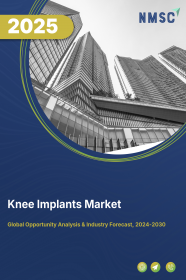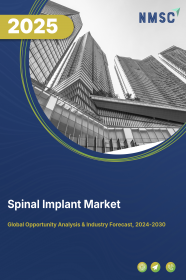
Knee Implants Market by Type of Procedure (Total Knee Replacement, Partial Knee Replacement, and Revision Knee Replacement), by Device Type (Three-Compartmental Knee Implants, Bi-Compartmental Knee Implants, and Uni-Compartmental Knee Implants), by Component (Femoral, Tibial, and Patellar), by Material (Stainless Steel, Cobalt and Chromium Alloys, Titanium and Titanium Alloys, Tantalum, Zirconium, and Others), and Others – Global Opportunity Analysis and Industry Forecast, 2024-2030
Market Definition
The global Knee Implants Market size was valued at USD 11.76 billion in 2023 and is predicted to reach USD 17.45 billion by 2030 with a CAGR of 5.8% from 2024 to 2030. Knee implants, also known as knee prostheses or total knee replacements, are medical devices used to replace damaged or diseased knee joints.
These implants are comprised of metal alloys, high-grade plastics, and polymers. They are surgically implanted to restore function and alleviate pain in individuals suffering from severe arthritis, traumatic injury, or other conditions that have caused irreversible damage to the knee joint.
It replicates the natural anatomy and movement of the knee, allowing for improved mobility and quality of life for patients. The procedure involves removing damaged bone and cartilage from the knee joint and replacing them with artificial components that recreate the joint's structure and function.
Market Dynamics and Trends
The growing prevalence of arthritis among the middle-aged and older population increases the demand for knee implants which stimulates market growth. Additionally, healthcare providers are investing in improved surgical techniques to ensure optimal outcomes for individuals undergoing knee replacement procedures.
This synergy between increasing demand and technological advancements underscores the dynamic nature of the knee implants market, shaping the future of orthopedic care for arthritis patients worldwide. Also, the growing occurrence of obesity at a significant rate further contributes to the demand for knee implants. Obesity causes osteoarthritis, particularly in weight-bearing joints including knees.
As obesity rates continue to rise globally, the incidence of osteoarthritis increases accordingly, prompting the requirement for surgical interventions such as knee replacements. This trend amplifies the demand for knee implants, as obese individuals require specialized implants capable of withstanding higher loads and providing long-term durability, which in turn boosts the knee implants market growth.
However, the absence of skilled professionals and the high cost associated with knee implants surgeries are the factors restraining the growth of the market. On the other hand, technological advancements in knee implantation such as the introduction of artificial intelligence utilized by the healthcare industry for total knee replacement surgeries and unit-compartmental knee arthroplasty are expected to create ample growth opportunities for the knee implants market in the coming years.
Market Segmentations and Scope of the Study
The knee implants market is segmented based on the type of procedure, device type, implant type, component, material, fixation material, design, surgery type, polyethylene inserts, end-user, and geography.
Based on the type of procedure, the market is divided into total knee replacement, partial knee replacement, and revision knee replacement. Based on device type, the market is segmented into three-compartmental knee implants, bi-compartmental knee implants, and uni-compartmental knee implants.
Based on components, the market is categorized into femoral, tibial, and patellar. Based on material, the market is divided into stainless steel, cobalt and chromium alloys, titanium and titanium alloys, tantalum, zirconium, and others. Based on fixation material, the market is divided into cemented, cementless, and hybrid.
Based on design, the market is segmented into cruciate-retaining and posterior stabilized design. Based on surgery type, the market is segmented into traditional surgery type and technology-assisted surgery type.
Based on end-users, the market is categorized into hospitals, ambulatory surgical centers, and others. Geographic breakdown and analysis of each of the aforesaid segments include regions comprising North America, Europe, Asia-Pacific, and Row.
Geographical Analysis
North America holds the dominant share of the knee implants market and is expected to continue its dominance during the forecast period. According to the Food Research and Action Center, the latest data reveal that 39.6 percent of U.S. adults are obese. This high prevalence of obesity in the region contributes significantly to the demand for knee implants.
Obesity is a well-established risk factor for osteoarthritis, particularly in weight-bearing joints like the knees. As obesity rates continue to rise in North America, there is an increased incidence of knee-related issues, leading to a greater need for knee replacement surgeries and implants.
Consequently, the combination of North America's market dominance in knee implants and its high obesity rates underscores the region's pivotal role in driving market growth and innovation within the orthopedic industry.
Moreover, the presence of key market players such as DePuy Synthes, Stryker, ConforMIS, and others underscores the competitive dynamics within the knee implants market. These leading companies bring extensive expertise, advanced technologies, and innovative product portfolios to address the evolving needs of patients and healthcare providers.
Their continuous investment in research and development, strategic partnerships, and expansion initiatives not only drives market growth but also fosters innovation, quality improvement, and market penetration. As such, their influence and contributions play a pivotal role in shaping the trajectory of the knee implants market in the region.
On the other hand, Asia-Pacific is expected to show a steady rise due to the increasing incidence of road accidents leading to knee injuries. Road accidents are a significant contributor to musculoskeletal injuries, including knee injuries, spinal cord injuries, and fractures, in the region.
According to the World Health Organization (WHO), road accidents caused 250,272 deaths in China alone in 2020. As a result, there is a growing demand for orthopedic interventions, including knee implants, to address the rehabilitation and treatment needs of individuals affected by these accidents.
Furthermore, the presence of a large geriatric population in countries including China significantly contributes to the growth of the knee implants market. According to the National Library of Medicine, the proportion of individuals aged 60 years and above in China is projected to rise from 12.4% (168 million) to 28% (402 million) by 2040.
As the population ages, there is an increased prevalence of degenerative joint diseases such as osteoarthritis, which often necessitate knee replacement surgeries. Consequently, the growing geriatric population in China and other Asia-Pacific countries fuels the demand for knee implants as a crucial orthopedic solution to enhance mobility and quality of life among elderly individuals.
This demographic trend underscores the significance of knee implants as a key medical intervention in addressing age-related joint issues and improving overall musculoskeletal health in aging populations.
Competitive Landscape
Various market players operating in the knee implants industry include DePuy Synthes, Zimmer Biomet, Stryker, Smith+Nephew, Aesculap Implants Systems LLC, Exactech Inc, Medacta, MicroPort Scientific, ConforMIS, and Kinamed, Inc.
These market players continue to adopt various market development strategies including new launches to maintain their dominance in the knee implants market. For instance, in May 2022, DePuy Synthes launched the Attune cementless fixed-bearing knee with Affixium 3DP technology for active patients undergoing total knee arthroplasty.
Also, in June 2022, Smith+Nephew launched the first robotic-assisted surgery using its Legion Conceloc Cementless Total Knee System. This implant is created in a virtual environment and manufactured through 3D printing additive manufacturing to optimize its spongy structure to promote bony ingrowth.
Moreover, in August 2021, Zimmer Biomet and Canary Medical launched the world's first smart knee named Persona IQ for total knee replacement surgery. It is Zimmer Biomet's proven and trusted knee implant with sensor technology that helps to measure and determine range of motion, step count, walking speed, and other gait metrics.
Key Benefits
-
The report provides quantitative analysis and estimations of the knee implants market from 2024 to 2030, which assists in identifying the prevailing market opportunities.
-
The study comprises a deep-dive analysis of the current and future knee implants market trends to depict prevalent investment pockets in the market.
-
Information related to key drivers, restraints, and opportunities and their impact on the knee implants market is provided in the report.
-
A competitive analysis of the players, along with their market share is provided in the report.
-
SWOT analysis and Porter's Five Forces model are elaborated in the study.
-
Value chain analysis in the market study provides a clear picture of the roles of stakeholders.
Knee Implants Market Key Segments
By Type of Procedure
-
Total Knee Replacement
-
Partial Knee Replacement
-
Revision Knee Replacement
By Device Type
-
Three-Compartmental Knee Implants
-
Bi-Compartmental Knee Implants
-
Uni-Compartmental Knee Implants
By Component
-
Femoral
-
Tibial
-
Patellar
By Material
-
Stainless Steel
-
Cobalt and Chromium Alloys
-
Titanium and Titanium Alloys
-
Tantalum
-
Zirconium
-
Others
By Fixation Material
-
Cemented
-
Cementless
-
Hybrid
By Design
-
Cruciate Retaining
-
Posterior Stabilized Design
By Surgery Type
-
Traditional Surgery Type
-
Technology Assisted Surgery Type
By End-User
-
Hospitals
-
Ambulatory Surgical Centers
-
Others
By Region
-
North America
-
The U.S.
-
Canada
-
Mexico
-
-
Europe
-
The UK
-
Germany
-
France
-
Italy
-
Spain
-
Denmark
-
Netherlands
-
Finland
-
Sweden
-
Norway
-
Russia
-
Rest of Europe
-
-
Asia-Pacific
-
China
-
Japan
-
India
-
South Korea
-
Australia
-
Indonesia
-
Singapore
-
Taiwan
-
Thailand
-
Rest of Asia Pacific
-
-
Rest of the World
-
Latin America
-
Middle East
-
Africa
-
Key Players
-
DePuy Synthes
-
Zimmer Biomet
-
Stryker
-
Smith+Nephew
-
Aesculap Implants Systems LLC
-
Exactech Inc.
-
Medacta
-
MicroPort Scientific
-
ConforMIS
-
Kinamed Inc.
REPORT SCOPE AND SEGMENTATION:
|
Parameters |
Details |
|
Market Size in 2023 |
USD 11.76 Billion |
|
Revenue Forecast in 2030 |
USD 17.45 Billion |
|
Growth Rate |
CAGR of 5.8% from 2024 to 2030 |
|
Analysis Period |
2023–2030 |
|
Base Year Considered |
2023 |
|
Forecast Period |
2024–2030 |
|
Market Size Estimation |
Billion (USD) |
|
Growth Factors |
|
|
Countries Covered |
28 |
|
Companies Profiled |
10 |
|
Market Share |
Available for 10 companies |
|
Customization Scope |
Free customization (equivalent up to 80 working hours of analysts) after purchase. Addition or alteration to country, regional, and segment scope. |
|
Pricing and Purchase Options |
Avail customized purchase options to meet your exact research needs. |




















 Speak to Our Analyst
Speak to Our Analyst





















